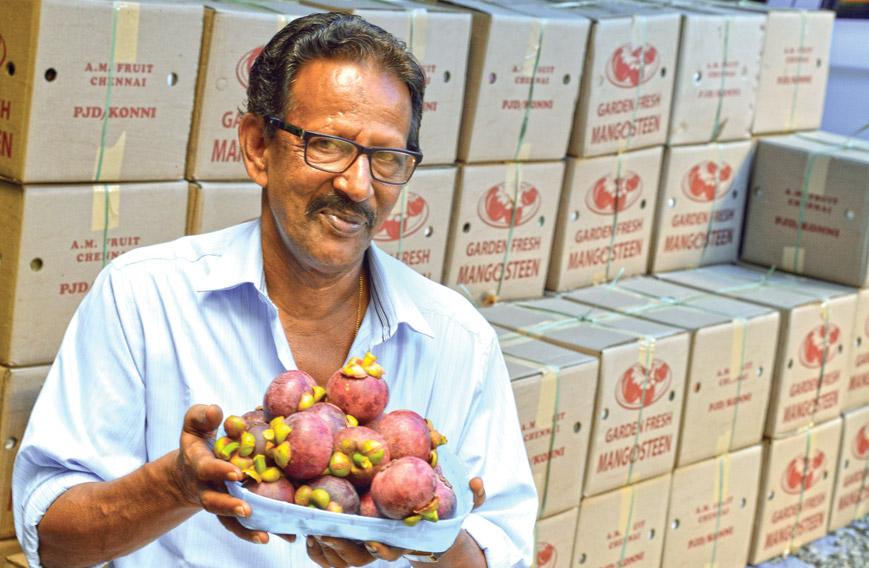
Mangosteen bonanza in Kerala village
Shree Padre, Chalakudy
The road to the spectacular Athirapally Falls passes through Pariyaram, a little known village near Chalakudy town in Thrissur district of Kerala. Tourists don’t stop here. There is no reason to except one — mangosteen, a fruit of Indonesian origin, is grown so successfully in Pariyaram that it is called ‘mangosteen village’.
Pariyaram earns more than Rs 1 crore annually from this fruit. The village has struck an unusually farmer-friendly deal with a buyer in Chennai. The fruit is assessed while it is still growing on the tree and the farmer is paid in advance. Only then are harvesters sent in to pluck the fruit, pack it and load it on a bus going straight to Chennai, avoiding random middlemen.
No government subsidy exists for mangosteen. Nobody promoted its cultivation. Not a single folder has been printed about it. Yet mangosteen cultivation is spreading just by word of mouth. Neighbours first noted the tree’s progress in adjacent fields and then decided to plant their own mangosteen trees. There is probably no house in Pariyaram that doesn’t own one or two mangosteen plants. A few have five or 10 trees. A sizeable number of households have a coppice of over 50 trees.
It isn’t as if mangosteen (Garcinia mangostana) is grown only in Pariyaram. Many parts of Pathnamthitta and Ernakulam districts grow it too. But nowhere is the crop grown as abundantly as in Pariyaram village. Nowhere is the fruit tastier. Yet, strangely, there is no local demand. The people of Kerala don’t know about this small money-spinner that is thriving in their midst.
M.K. Marlin, a 58-year-old farmer, is the architect of the village’s marketing strategy. Marlin pioneered mangosteen cultivation in Pariyaram.
For two months, from April 25 every year, Marlin’s shed is a hive of activity. Almost the entire mangosteen crop of the village is pooled here. Action begins at the crack of dawn. By 7 am, on alternate days, Marlin sends out 38 harvesters and 10 villagers to each mangosteen household in the village to collect the fruit and bring it to his shed.
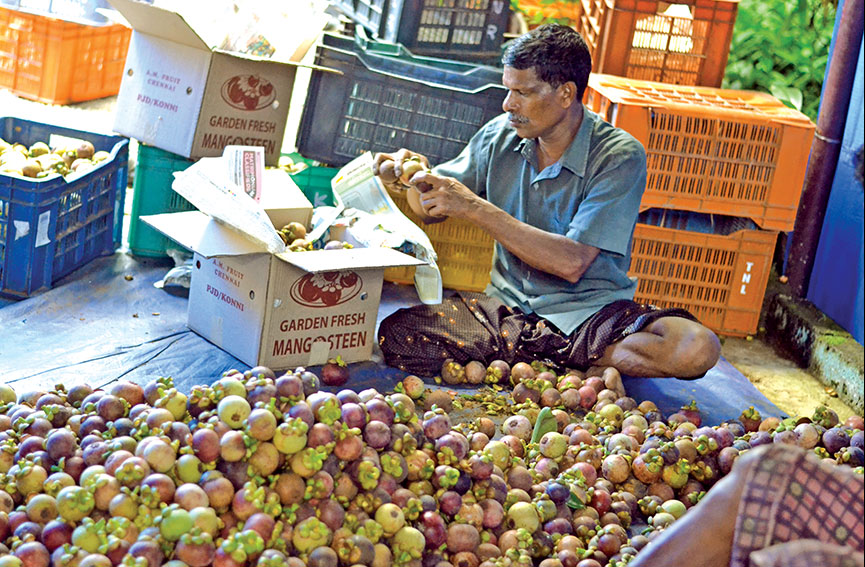
Mangosteen is a climacteric fruit. This means once the fruit is plucked, it undergoes rapid changes resulting in a short shelf life at ambient temperature. The fruit grows on the tree singly and not in bunches. So locating each fruit nestled amid dark green shiny leaves needs a sharp eye and patience. Harvesting the fruit also needs a tender touch. Although mangosteen has a thick skin, it gets damaged if it falls and broken fruit doesn’t sell.
That’s why Marlin picks youngsters to harvest the fruit. They don’t have to go beyond a 20-km radius. The young harvesters climb the trees with a long stick fitted with a net at one end. The ripe fruit has a paler green colour, tinged with violet.
Once the fruit arrives it is packed into cardboard boxes by a team of five. The buyer in Chennai, who pays a wholesale price for the fruit, supplies the 10-kg boxes. The packing work continues uninterrupted as loads from nearby areas come in intermittently after 10 am. By 4 pm, the packing is completed.
Then Marlin’s shed buzzes with a different set of activities. The fruit crates are unloaded and some fruit is rejected. The boxes are weighed and stacked. The packers have a deadline so everything is done with clockwork efficiency.
Every evening a private bus from Ernakulam bound for Chennai picks up these fruit boxes. It stops in Chalakudy town to collect some more boxes of mangosteen. The next morning, by 7 am, the fruits reach the wholesale market at Koyambedu in Chennai. The fruit is unloaded, auctioned and supplied to different buyers in nearby towns and cities. In fact, the fruit reaches the end consumer the very next day after being harvested.
The season begins with two or three quintals of the fruit being collected. At that stage mangosteen fetches a high price of Rs 400 per kg in Chennai. During the peak season every day two tonnes — 200 boxes — are sent to Chennai from Pariyaram. The price is lower during this time.
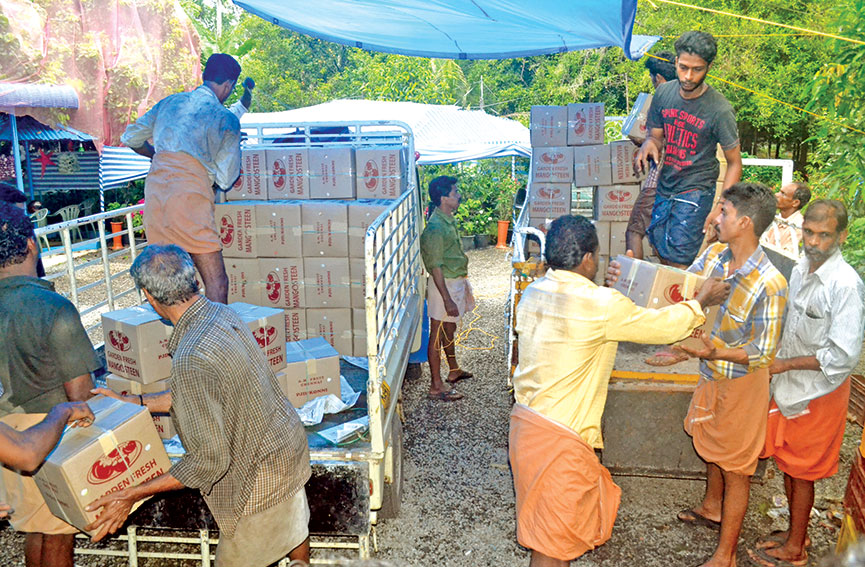
Joshua Daniel, a trader from Pathnamthitta, has been consistently buying mangosteen from Pariyaram for the past 50 years. Marlin partners him in coordinating the sale, procurement, packing and transport of the fruit to Chennai.
When the mangosteen trees begin to flower, Daniel’s son, Siby Joshua, arrives in the village. He lives in Chalakudy for four months to initiate the business of selling mangosteen.
Marlin and Sibi visit mangosteen farmers. They assess the crop and quote a price. The buyer in Chennai pays for harvesting and transport. If a deal is struck, a token advance is paid immediately to the farmer. The balance is paid before the start of the first harvest. This year, Rs 80 lakh was paid in advance to all mangosteen farmers. Five years ago, the initial money paid was Rs 20 lakh.
“I am very satisfied with mangosteen,” says K.C. John, 75, a retired teacher. He has about 60 mangosteen trees and an equal number of nutmeg trees on his land, which is a little more than an acre. A few tall coconut trees, standing like umbrellas, complete the picture.
Last year John earned Rs 1.75 lakh from mangosteen and Rs 1 lakh from nutmeg. He estimates that his annual yield of mangosteen is about four tonnes. This year he got Rs 3 lakh from mangosteen and around Rs 1.5 to 2 lakh for nutmeg. He also has a few fecund rambutan trees which fetch him an income.
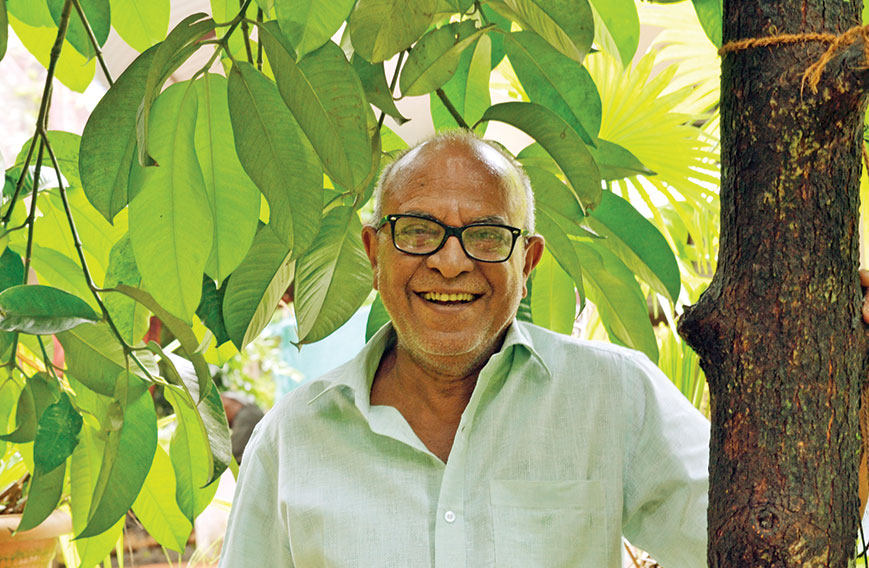
Another farmer, A.D. George, has only five mangosteen trees in his compound. These have been yielding fruit for the last five years. His one-acre homestead has 50 nutmeg trees around 20 years old. George says he earns Rs 1 lakh from nutmeg and around Rs 30,000 from mangosteen.
“From the farmer’s point of view I feel mangosteen is a far better crop,” he says. “We have to harvest nutmeg ourselves every two or three days for about six months in the year. Its peak output is during the rainy season. So we have to dry it artificially. Now look at mangosteen. The buyers themselves harvest the fruit. Its main fruiting time is over in just two months. Most of the crop is harvested before the onset of the monsoon.”
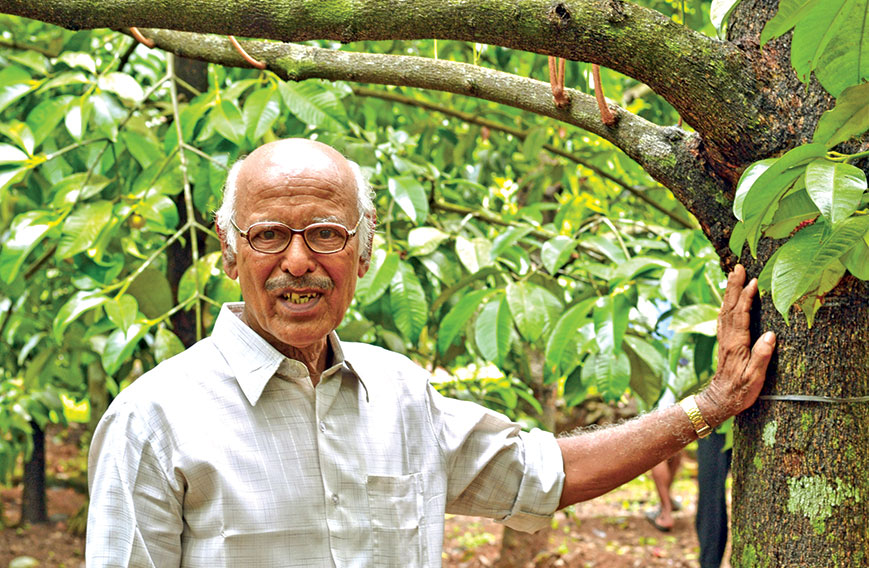
Like John and George, each homestead has a mix of crops. Nobody grows mangosteen as a monocrop — in an orchard. This is because initially everyone started planting mangosteen for their own consumption. Once they realised its commercial potential, farmers started planting more and more trees.
The mangosteen tree grows to a height of six to 25 metres. The whitish fruit pulp is sweet and juicy with a very pleasant aroma. Its deep reddish-purple rind is not edible. Once ripened, the rind turns soft. The fruit contains five segments, two with seeds and the rest seedless and wholly edible. The seeds are used for propagation.
The first tree
So how did mangosteen, an unknown fruit in India, find fertile ground in Pariyaram? Marlin says that, nearly a century ago, his great-grandfather, Moothedan Varghese, went to Malaysia for higher studies. When he returned to his village, people would address him as ‘beeyekkaran’ — one who has studied up to BA level. At that time, just six people had college degrees.
He also brought some mangosteen seeds from Malaysia. From those seeds came the village’s first mangosteen tree. It is now 90 years old and still yields around 600 kg of fruit. This tree, whose progeny brought prosperity to the village, now stands on Kevin Nicholas’ land. He bought the tree from a member of Marlin’s family a few years ago.
The first saplings of the mother tree are now about 60-70 years old. About three or four Moothedan households own 50 old trees. Since the tree is rare and its fruit tasty it was gifted to Moothedan girls when they got married. Soon, 40 households were growing mangosteen.
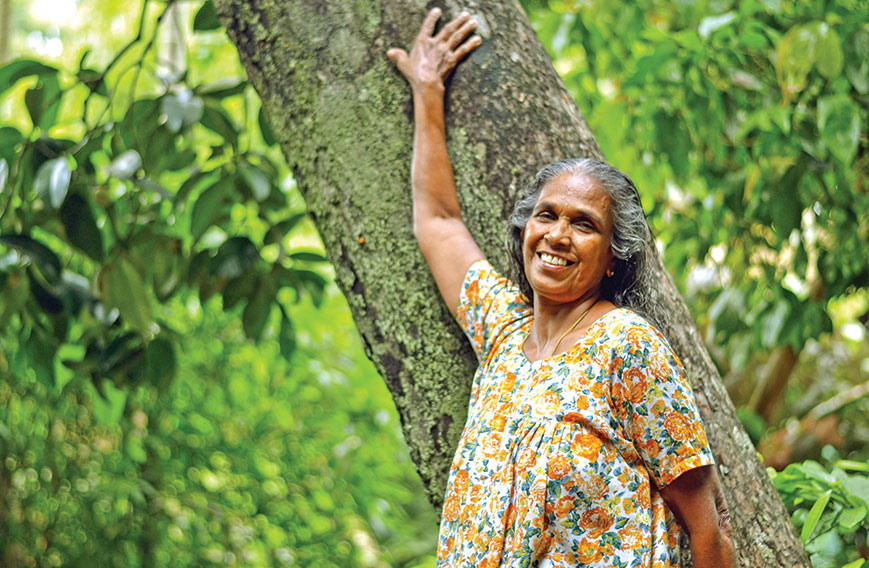
In 1991 Marlin planted 100 mangosteen plants in his coconut garden. “It wasn’t because I was disappointed with my coconut trees,” recalls Marlin. “Everywhere in cities I used to see truckloads of grapes, oranges and other fruit arriving. All these fruits used to be sold sooner or later. It wasn’t as if the fruit turned rotten because there were no buyers.”
Marlin concluded that fruit always had a bright future. So he decided to try out mangosteen. Moothedan families were sentimental about the fruit since their renowned forefather had introduced it. The first batch of trees Marlin planted began yielding fruit in four years although he cautions that it is best to give the tree a five-year gestation period.
Marlin didn’t sell the fruits his trees yielded the first time. Instead, he presented the fruit to friends and relatives. It was the second year’s fruit that he took to Ernakulam to sell. “I got `30 per kg, but it was a good price in those days,” he says. This initial success prompted him to plant mangosteen in a big way. He now has 600 trees interspersed between his coconut trees on his 5.5-acre coconut garden. All of them yield fruit. In all probability, Marlin’s farm yields the most mangosteen fruit in Kerala and in all of India.
Mangosteen requires light shade and good irrigation. Perhaps because Pariyaram is a water-rich area, all the households we visited had opted for flood irrigation that requires a huge amount of water.
Plants and seeds
Marlin invested in a nursery 15 years ago. Every year, the nursery produces 40,000 to 50,000 plants for sale. Apart from seedlings he has plants that are two, three and four years old too. Many buyers prefer to purchase older plants since their gestation period is lower.
In fact, Marlin wanted to keep the entire mangosteen crop of one year just to raise plants. “But the kind of demand we had for the fruit didn’t permit me to do so,” he says. So he settled for injured or broken fruit for seed selection. Mangosteen seedlings perform much better than grafts so they are in high demand.
Pariyaram village has witnessed many ups and downs in the past 50 years. For a long period, coconut was the main crop here. “Our foundation was coconut. My father, Kurien, built this house and developed assets only with income from coconut,” recalls Marlin. But the coconut trees got afflicted by root wilt and other diseases. Labour became scarce. The coconut trees are still there but coconut isn’t seen as a lucrative crop anymore.
In the mid-Nineties nutmeg began winning the hearts of farmers. And then mangosteen began attracting attention. From the farmer’s point of view, mangosteen is easier to harvest and can withstand a few days of water-logging. Nutmeg cannot. It is fragile and prone to fungal disease. Mangosteen trees are more hardy.
“Nutmeg fetches a price of `200 per kg. Even if you get half of that for mangosteen, it is still a better crop for us,” says Marlin, “From a unit area, we get three times what we get from nutmeg.”
K.C. John’s garden clearly illustrates the farmer’s priorities. He has grown mangosteen trees between nutmeg. In fact, both compete for sunlight. John has heavily pruned his nutmeg trees to ensure that mangosteen’s yield doesn’t decline because of lack of sunlight.
Why does mangosteen from Pariyaram fetch such a high price? “In this village the fruit matures a fortnight before other mangosteen-growing villages. In other words, just when the temperature rises in Chennai in summer and demand for fruit increases, our mangosteen fruit is ready. Besides, farmers in Pariyaram take care of their mangosteen trees and pamper them with irrigation and fertilisers,” explains Daniel.
Rich soil
K. Kumaran, an associate professor of history in a private college and a family friend of Marlin, says: “I have visited Ranni and Konnietc in Pattanamthitta district where mangosteen is widely grown. You don’t get mangosteen of the same quality as Chalakudy taluk anywhere in Kerala. The reason is the rich alluvial soil here. It’s the environment that produces such top-class mangosteen.”
But a big drawback is that there is absolutely no local demand. For several years, Marlin would send his consignment of mangosteen to bigger cities like Thrissur and Ernakulam. Unlike mango or pineapple, just a few quintals would be bought.
“If it rains in Ernakulam, demand for mangosteen suddenly goes down,” says Marlin.
The marketing opportunity in Chennai, started five years ago, has made a world of difference to mangosteen farmers. “There is no tension now,” says Marlin. “No other crop fetches us the kind of income that mangosteen does. A farmer with just one acre of fruit trees can earn up to Rs 6 lakh at the prevailing rate.”
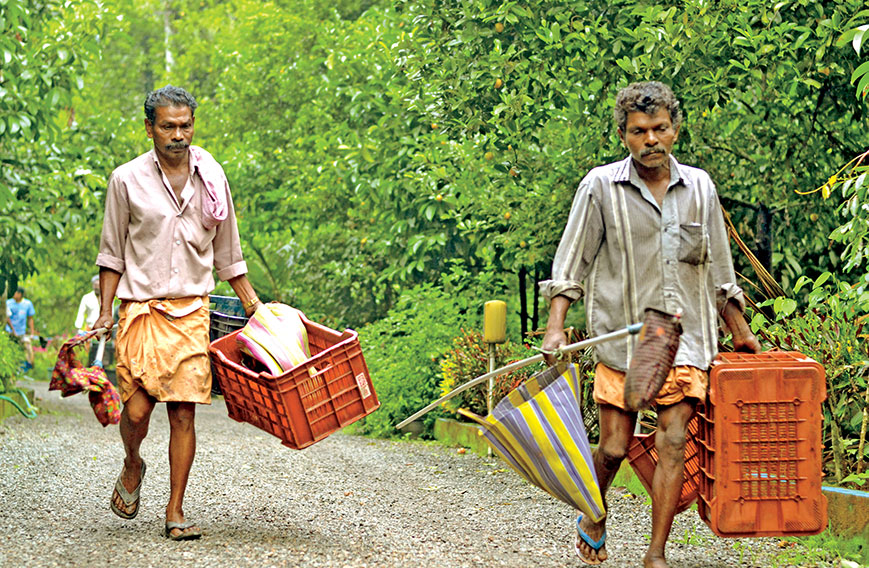
There are many farmers in Pariyaram who own 50-100 trees. Not all farmers sell their crop to Daniel. About 20-30 percent of mangosteen is now sold to other buyers. Lately, some traders who buy the entire crop in advance, harvest and send the fruit to local markets have made their presence felt.
Daniel’s network spreads beyond the revenue boundaries of Pariyaram village. He buys a small percentage of mangosteen from neighbouring areas as well. This year Pariyaram’s fruit was worth about Rs 1 crore from around 100 farmers. The average weight of one fruit is between 80 and 100 gm. Currently, Marlin does not grade the fruit though it does vary in size. When prices start declining, grading becomes necessary.
The yield of mangosteen in the village has been increasing over the years. “Our Chennai buyer requires only two tonnes per day. But we are on the verge of crossing this figure. Everything is fine right now and returns are good but there is an element of risk. If demand turns sluggish in Chennai, they will ask us not to send maybe for a day. But we can’t stop harvesting,” says Marlin.
Future demand
Farmers here worry about what future demand will be. In India, mangosteen, a tropical evergreen tree, is being grown only in the south. At 1,000 tonnes, Kerala is India’s leading mangosteen producer followed by Tamil Nadu where an estimated 200 tonnes of mangosteen is grown in Pollachi, Upper Palani hills and Coonoor. Karnataka comes third. It grows about 100 tonnes. But no real study has been done and these are just rough estimates. A few farmers in Pune and Thane are also cultivating mangosteen.
“Karnataka will overtake Kerala in a few years,” predicts Jacob Chalissery, a farmer. “The overall situation in Kerala is not that conducive for exotic fruits like mangosteen.” A few people from Kerala have started growing mangosteen in Karnataka’s Dakshina Kannada district.
They know mangosteen cultivation is slowly catching up in Kerala and Karnataka. “The fact that there is no local demand for the fruit puts a big question mark on our future,” says Marlin. Currently, the average price Pariyaram farmers get for mangosteen works out to around Rs 150 per kg. “Even Rs 100 is good for us,” says Marlin.
There are two factors that come in the way of creating a market for mangosteen in North India and other regions where it hasn’t made its presence felt. First, there is lack of awareness. Many people don’t know of the fruit at all.
People who travel to Southeast Asia get to know about mangosteen and create a demand for the fruit when they return. Then, many youngsters from Hyderabad are studying in Ooty. These students and their parents sample mangosteen in Ooty. But when they go to buy the fruit in high-end shopping malls they find the price too steep. This year, it varied from Rs 600 to Rs 1,200 per kg. Those who have eaten the fruit in Bangkok or Malaysia begin wondering why the price is so steep here.
“Mangosteen has a good future if we make it reasonably affordable,” says Jacob Chalissery, a mangosteen grower. He recently tied up with a mall in Bengaluru and insisted they sell it for Rs 199 per kg. “Two stores of the same chain also sold mangosteen at this rate. The result was that demand rose steeply. Initially, around 10-20 kg of the fruit sold. In two or three weeks the figure reached one tonne,” he says.
“If we sell directly to the consumer, mangosteen will become a very sustainable crop. We need to sell the fruit at a farm gate price of Rs 50. Then we won’t face any market crisis,” says Chalissery.
Mangosteen has a shelf life of a fortnight under ambient conditions but there are issues. To send the fruit far, trays or boxes are required that would insulate it from damage and from the weather. In the peak of summer, rising temperature and lower humidity tends to dehydrate the fruit.
“It’s time the government thought about creating cold storage facilities in rural areas where fruit and flower production is good. Unfortunately, the political set-up here does not encourage such facilities in villages,” rues a farmer.
“When I planted mangosteen trees three decades ago, I didn’t dream that it would expand so much and change the fortunes of our village,” says Marlin with a hearty laugh. Of course, like him, most households planted mangosteen initially with the simple objective of getting enough fruit for the family. It didn’t strike them that they had been blessed with a cash cow.
Contact: M.K. Marlin – 9400846369



